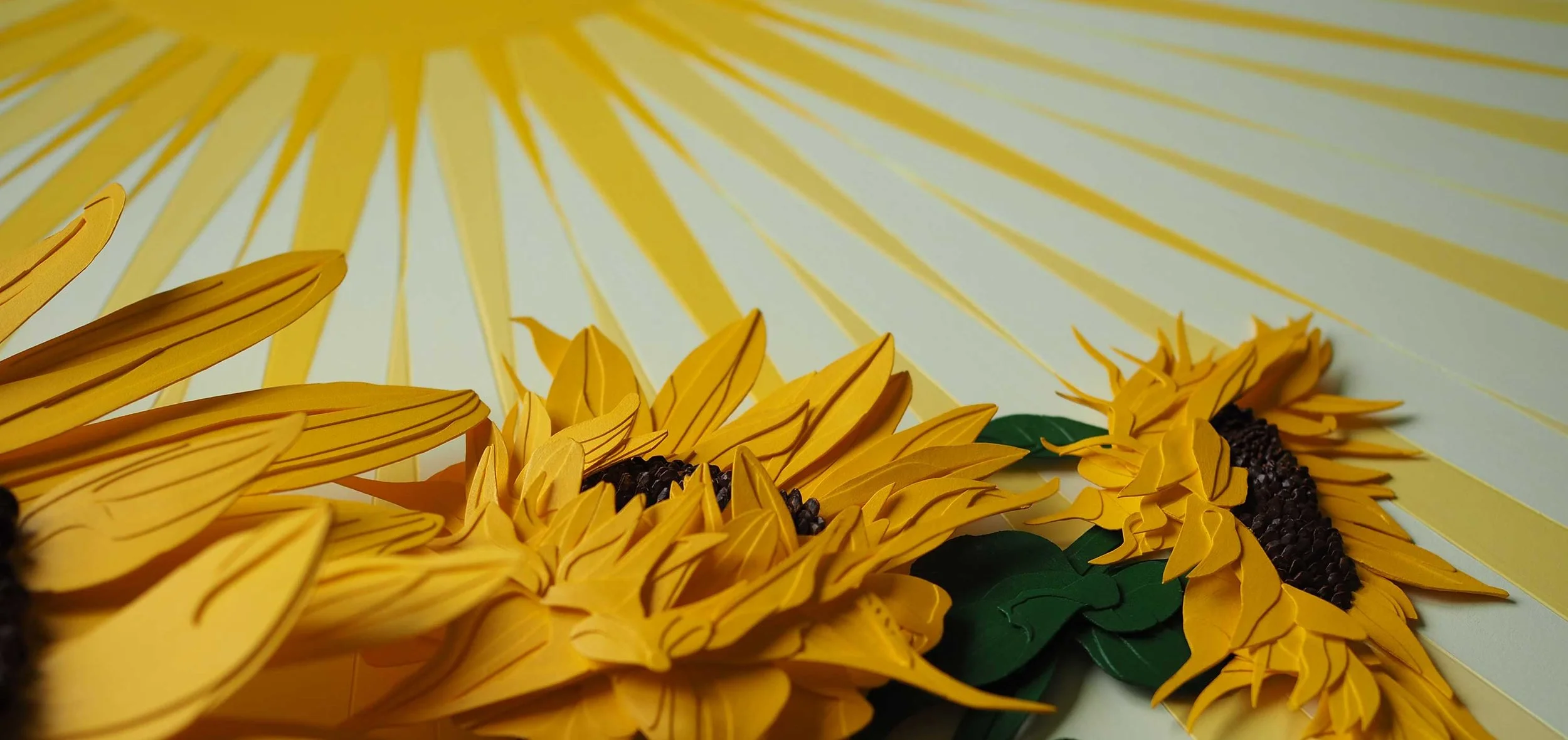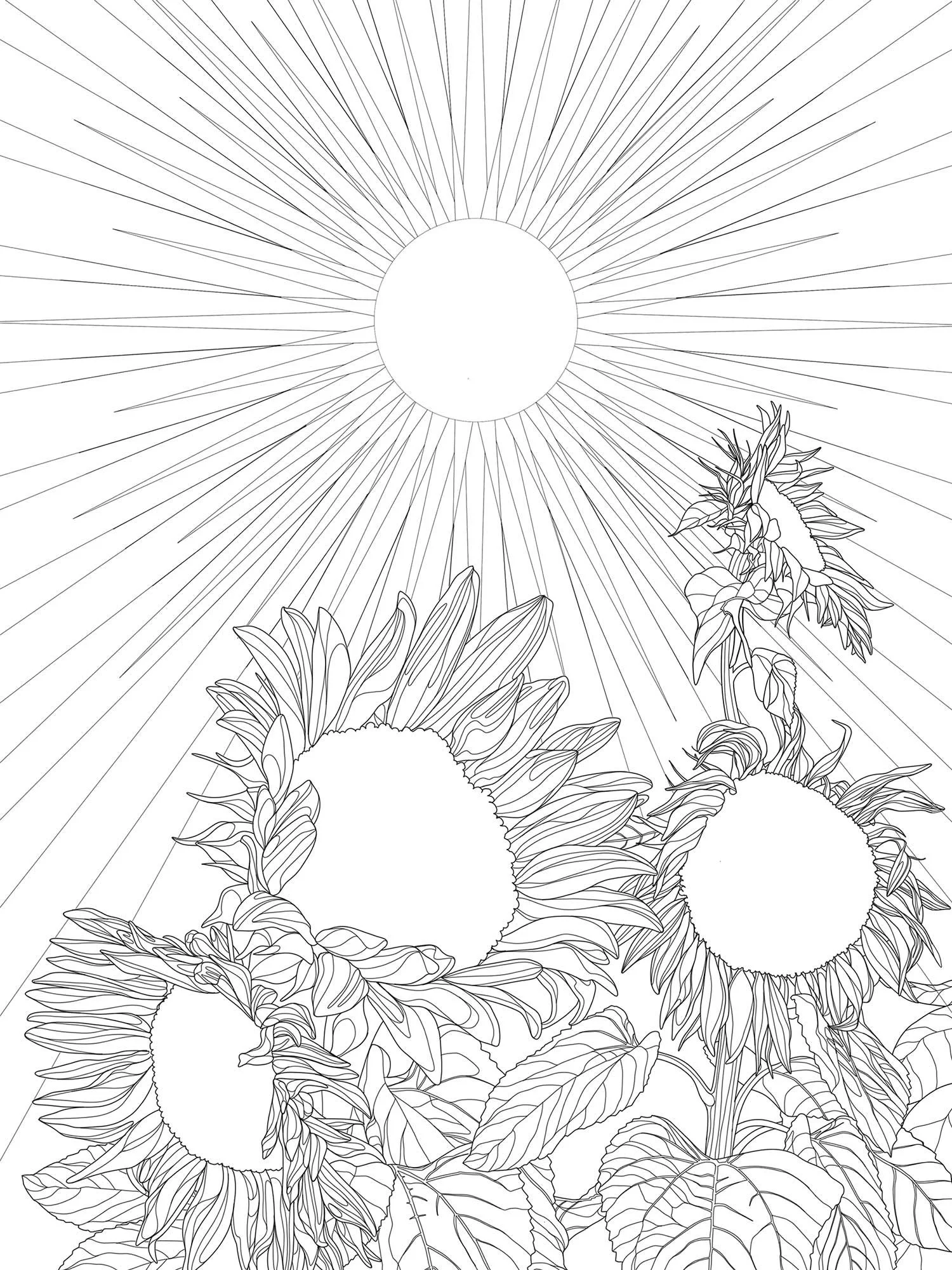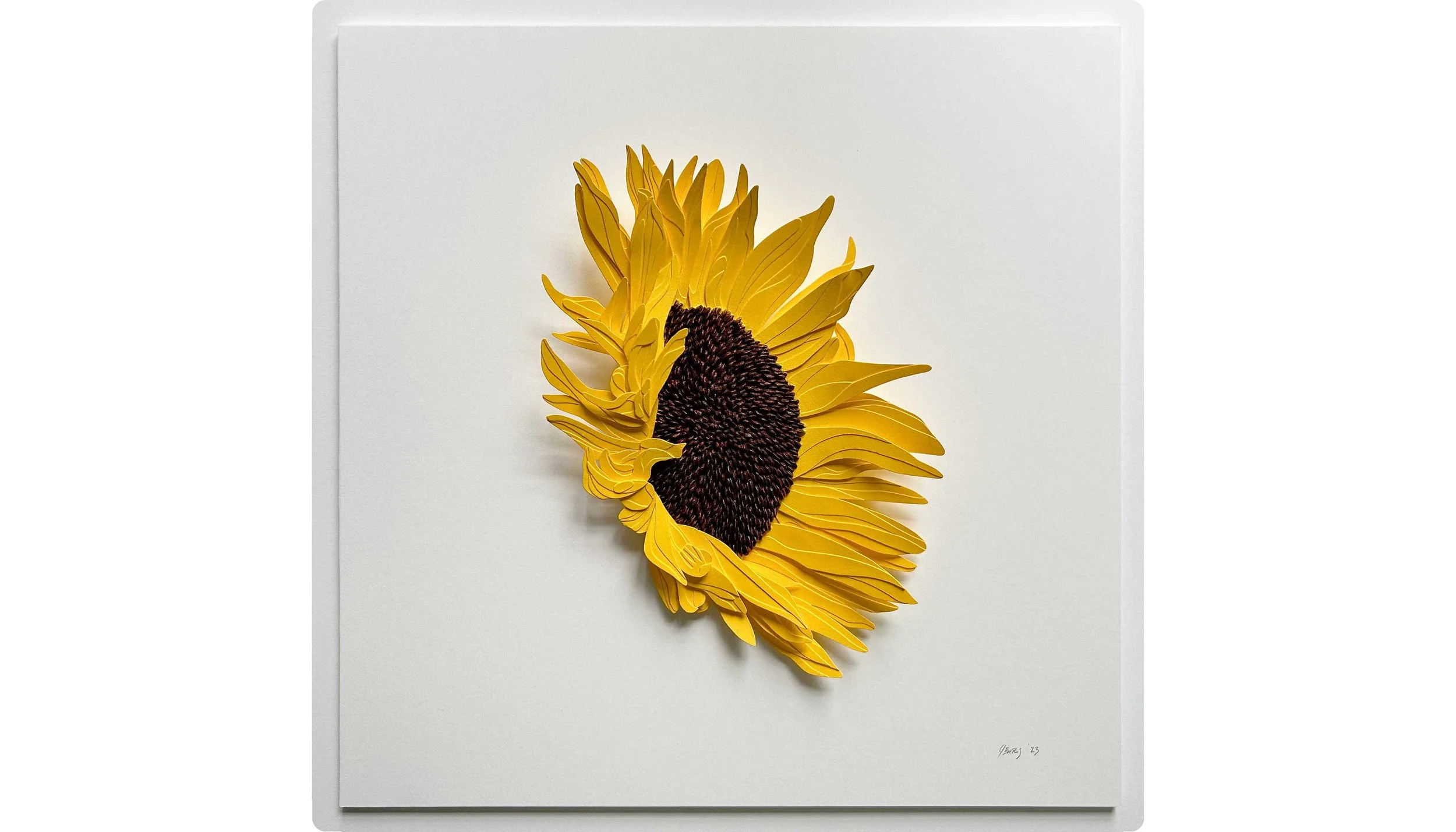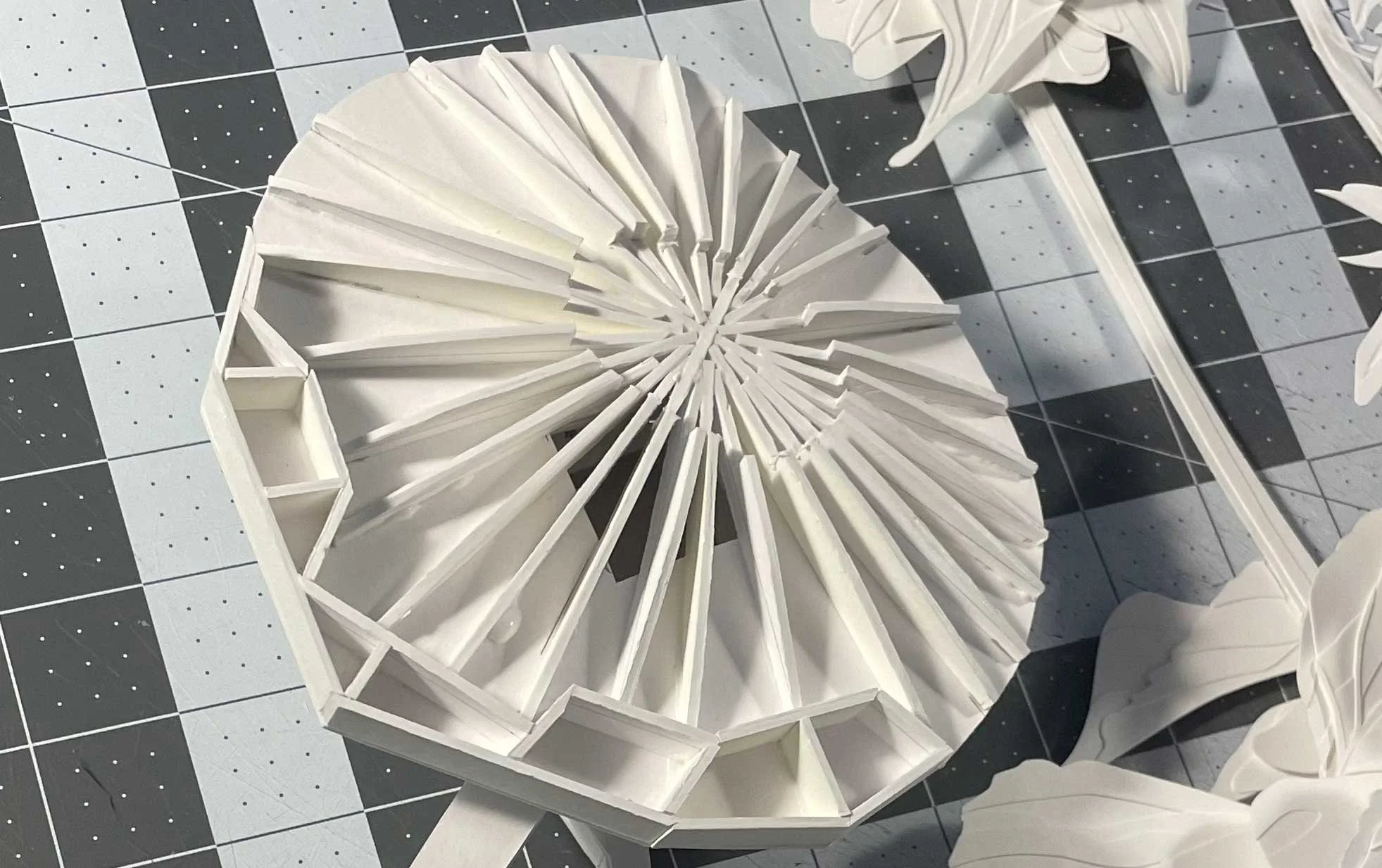The Sunflowear Commission
An in depth look at the making of a commissioned paper sculpture
In august of 2023 I was commissioned to make a paper sculpture with sunflowers and a depiction of the sun.
In my twenty plus years making art I have taken on several commissions, where people have asked for custom pieces to be made specifically for them, a loved one, or a space that they would like to have something unique occupy.
Paper sculptures can take anywhere from weeks to months to complete. What follows is a breakdown of the making of this piece.
Composition
The piece kicked off in late summer of 2023. I was on the heels of making several cut paper sculptures treating individual flowers almost as portraits. The flower “portraits” all seemed to touch on big things, grief, death, and loss. Each retaining a sort of character. In this one I was intent on bringing character into each sunflower.
My commission process is interactive in the early phases. A client comes to me with an idea/ desired piece based off what I’ve made before. In recent commissions I have started asking for more feedback and input from the clients in the beginning stages of the piece.
I do several thumbnail sketches to sort out the composition of the piece and share those thumbnails with the client to find which one works best for them. Once we’ve agreed on the composition I get to work sourcing reference material. I work from photos found everywhere from my own phone to the internet and magazines. The drawing is made from a hodgepodge of reference material will serve as my guide.
I do my best not to repeat flowers. I relish detail and want for the pieces to be lush and full of interest. When everything is uniform it feels like nails on a chalkboard to me. In nature there are repeating patterns, but the chances of petals being the same shape and size is fantastically rare, if occurring at all.
Study
With the composition set and the guide drawn out I made a sunflower study before beginning work on the final piece. The problem child, or children of this piece were the sunflower seeds. Each was cut individually, out of illustration board and their edges chamfered one by one. ( chamfered means a cut on the edge or corner of something that makes it slope slightly rather than being perfectly square.)
The study was a success and surprisingly, to me, had a quasi-realistic feel to it. One thing I like about working with layered paper and glue is that the glue tends to warp the paper while drying. During the drying process there is the possibility to manipulate the paper. I can curve the petals to give them more depth.
The finished study.
The base of the largest flower.
Bases and seeds
I made each flower with a base built out of illustration board. The petals were cut one by one and numbered to correspond with the guide. I want each petal to be unique to push the realism and keep the eye’s attention when viewed. The petals consist of three to eight layers of paper glued together then carved around the edges to keep them from looking like chunky biscuits.
Once the petals were glued in place I paper mâchéd over the illustration board and the inner most parts of the petals (sounds more provocative than it is). This process binds the base and the petals together while giving a solid surface for the paper sunflower seeds to be glued.
This piece has two different kinds of seeds, paper and polymer clay. Most of my work incorporates new techniques, often to make the work stronger or less time consuming. This time around I made silicone molds of sunflower seeds that were cut out of illustration board. It ended up taking the same amount of time to produce the polymer clay seeds as the paper ones due to prep time and the meticulous process of jamming clay into such small molds. On top of that, excess material had to be cut away from each seed cast. So, the polymer clay is used on only one of the flowers, the largest sunflower. In trying to make less time-consuming elements I try to keep the spirit of my hand made work alive, while maximizing my efforts the best I can.
Polymer clay seeds made using silicone molds of paper seeds.
The polymer seeds being glued down.
Painting the Flowers
After gluing down hundreds of polymer clay and paper seeds, the flowers were painted completely yellow. The seeds were given a layer of a brown glaze of acrylic paint mixed with a gloss medium. This gave them a warm hue and the gloss finish that differentiated the seeds from the petals in texture. The leaves were painted with four layers of a deep green due to the transparent quality of the paint used.
Each flower head was painted with a cadmium yellow medium hue. Two layers of brushed on paint, followed by a layer of spray-paint, using the same color.
As funny and embarrassing as this is, I’ve never considered expressing joy in my work. I’ve spent many years making sure I was not making kitschy things. The saccharin and sweet have been something to be avoided but joy is not kitsch. As this piece started to take shape, I started to embrace that joy is just as valid in art as the melancholic. The color scheme of this piece started to scream joy.
The sunflowers in the midst of painting.
Different versions of the sun.
Redesigning the Sun
Then there was the sun. While the guide had a certain design and placement, something wasn’t feeling right about it. Sometimes changes need to be made. The challenge here was to have it match the sculptural elements of the piece, but not become the focal point. I began with a cut out design and placed it around the piece to rework the composition. I conferred with the client, and we batted around ideas on how the sun should appear. I did several drawings on paper and on the iPad.
Laying the Foundations
The sun was set. The design ready to apply but needed to prep the board that would hold the piece. The board is a cradled piece of masonite, an engineered wood that is made by compressing fibers and different materials to make a board (cradled meaning there’s a structural frame behind it). Seven layers of primer were applied to the board to protect the paper elements from any sort of contact with the wood. After priming and sanding were finished the board was painted with three layers of acrylic white paint.
Throughout the month I carved the sun into the layers of paint and primer. Wooden pegs were strategically glued to the board to glue the paper flowers and leaves to it.
The sun carved before painting.
With paint.
Carving the Sun
The sun was carved into the layers of paint and primer. Wooden pegs were strategically glued to the board to secure the paper flowers to it. I carved valleys where the lines were to give depth and a “gutter” to receive the acrylic paint. This kept the lines sharp and clean. The orb of the sun was carved using woodcarving tools and sanded down to give it a bevel and the impression of a sphere.
The sun and its rays were painted using the same yellow that adorns the sunflowers, just mixed with white to varying degrees.
With the sun carved and painted the piece was glued together. This involved taking over the kitchen table and using towels, clamps, heavy books, and crossed fingers to ensure a proper gluing. I left it over night to cure. Luckily everything set in the right place!
My friend Alvaro photographing the completed sculpture
Documentation
With the piece complete it was photographed and filmed.
Since beginning of my paper sculpture work, I have had the work framed in white shadowbox frames. Recently I’ve been rethinking this since a few collectors have expressed interest in seeing the pieces from the sides. This piece is going to be framed in a plexiglass box frame. With plexiglass the piece will be protected while giving the viewer the opportunity to see the structural work that went into the build and the piece can have more breathing room with fewer shadows cast.
Shipping
The last step is building the shipping container. A box is built to hold the piece. I use a two-box method where the piece, wrapped in bubble wrap, is packaged in a custom cardboard box, built with braces to hold the piece securely. A second box is built to contain spacers to separate the inner box from the outer box. Most of the work I have sold from the studio goes off to North America. While the shipping containers like the one seen above may only be in use for a matter of days - DHL can get things around the globe relatively quickly - I do everything I can to protect the piece in transport.
And now…
…The Big Reveal
Sunflowers
Cut paper, glue, acrylic paint, and wood
24” x 32” x 4” ( 60.96cm x 81.28cm x 10.16cm)
2024
This commission in particular took a year of on and off work as I tackled a myriad of other projects. It was a constant in a year of a lot of growth. A long, tough winter came and went. This commission led me to embrace the fact that it is OK to express joy in one’s art. Many many thanks to the patron that commissioned this piece for their home!
The following breaks down how I do commissioned work.
What are you looking for?
Fill out the form below telling me what you are looking for in a custom piece
We will have a video call to talk details
A contract that clarifies the agreed upon plan will be drawn up
50% of the estimated cost is paid as a non refundable deposit.
I get to work
Once the deposit is received work on your commission commences
A piece can take anywhere from weeks to months to plan and complete.
Time frame depends on current work flow
I am happy to provide process pictures while making the piece.
You get a one of a kind
piece for your home
Upon completion the second half of the commission is paid.
The piece is carefully packaged and shipped off to you.
FAQ
Unless having an exclusive offer for my newsletter subscribers,
commissions start at $2000 USD
The initial estimate is subject to change based on time and materials.
(This has only happened once in about two decades of working with folks on commissions.)
The initial estimate does not include shipping.
The initial estimate does not include framing.
Most of my work is sold outside of the EU so a customs fee outside of the EU may occur.
Customs fees are dependent on the rules and regulations of the receiving country.




















